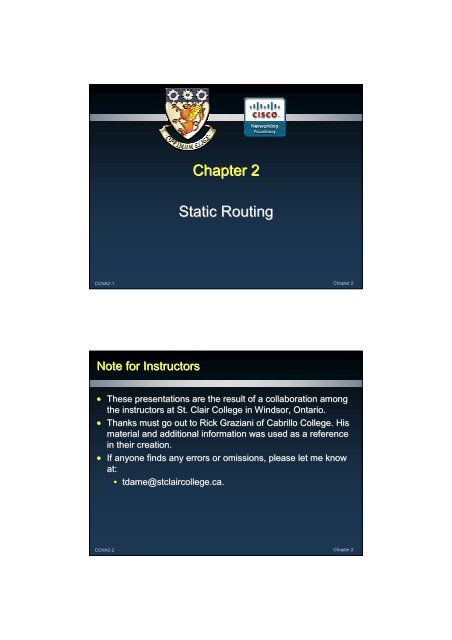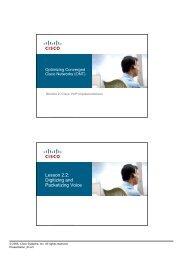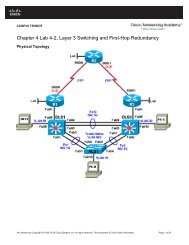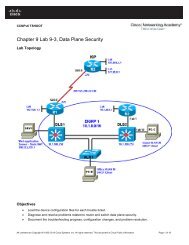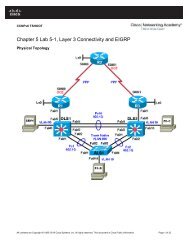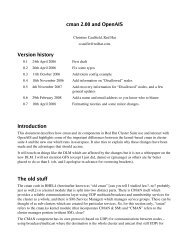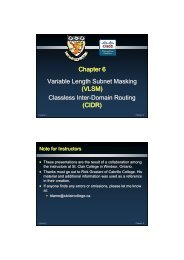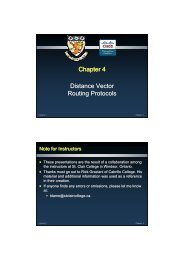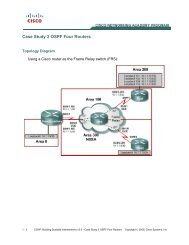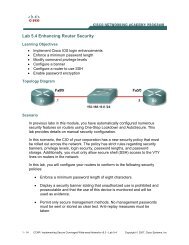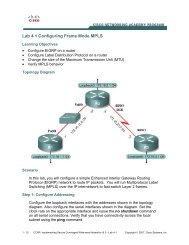Chapter 2 Static Routing
Chapter 2 Static Routing
Chapter 2 Static Routing
Create successful ePaper yourself
Turn your PDF publications into a flip-book with our unique Google optimized e-Paper software.
<strong>Chapter</strong> 2<strong>Static</strong> <strong>Routing</strong>CCNA2-1 <strong>Chapter</strong> 2Note for Instructors• These presentations are the result of a collaboration amongthe instructors at St. Clair College in Windsor, Ontario.• Thanks must go out to Rick Graziani of Cabrillo College. Hismaterial and additional information was used as a referencein their creation.• If anyone finds any errors or omissions, please let me knowat:• tdame@stclaircollege.ca.CCNA2-2 <strong>Chapter</strong> 2
Introducing the Topology• <strong>Chapter</strong> 2 Topology:CCNA2-5 <strong>Chapter</strong> 2Introducing the Topology• <strong>Chapter</strong> 2 Addressing Table:CCNA2-6 <strong>Chapter</strong> 2
Examining the ConnectionsSerialFastEthernetConsoleAuxiliaryPower• Unlike most user PCs, a router will have multiple networkinterfaces.• These interfaces can include a variety of connectors.CCNA2-7 <strong>Chapter</strong> 2Examining the Connections• Serial Connectors:• Cisco routers support the EIA/TIA-232, EIA/TIA-449,V.35, X.21, and EIA/TIA-530 standards.• Memorizing these connection types is not important.• Know that a router has a DB-60 port that can support fivedifferent cabling standards.CCNA2-8 <strong>Chapter</strong> 2
Examining the Connections• Serial Connectors:• A router is typically a DTE device.• The DTE cable is connected to the serial interface on therouter to a CSU/DSU device (DCE).CCNA2-9 <strong>Chapter</strong> 2Examining the ConnectionsDCEDTE• Serial Connectors:• In the real world, , the serial line is connected to a ChannelService Unit/Data Service Unit (CSU/DSU).• The CSU/DSU controls the line and controls the clockrate for the bandwidth set by the service provider.CCNA2-10 <strong>Chapter</strong> 2
Examining the ConnectionsDCEDTE• Serial Connectors:• In the lab, , the serial line is connected back-toto-back.• The router that has the DCE cable connected providesthe clock rate (bandwidth) by defining the specific clockrate to be used on the connection.CCNA2-11 <strong>Chapter</strong> 2Examining the Connections• Ethernet Connectors: Standard RJ45 UTP cables.• Switch-toto-Router• Hub-toto-Router• Switch-toto-PC/Server• Hub-toto-PC/Server• Switch-toto-Switch• PC/Server-toto-PC/Server• Switch-toto-Hub• Hub-toto-Hub• Router-toto-Router• Router-toto-PC/ServerCCNA2-12 <strong>Chapter</strong> 2
Examining the Connections• Console Connection: PC COM1 port using HyperTerminalCCNA2-13 <strong>Chapter</strong> 2Introduction to <strong>Routing</strong> and Packet ForwardingRouter Configuration ReviewCCNA2-14 <strong>Chapter</strong> 2
Examining Router Interfaces• show ip route:• Displays the routing table.• show interfaces:• Shows the status and gives a detailed description of allinterfaces on the router.• show interfaces [interface]:• Shows the status and gives a detailed description for aspecific interface on the router.• show ip interface brief:• Shows the status of all interfaces in a condensed format.CCNA2-15 <strong>Chapter</strong> 2Configuring an Ethernet InterfaceIndicates that physically, the connection is good.If you don’t t get this message, make sure that theinterface is properly connected.Indicates that the Data Link Layer is operational.On LAN interfaces, you do not normally changethe Data Link layer parameters. In the Lab, youwill be changing the WAN interface.CCNA2-16 <strong>Chapter</strong> 2
Unsolicited Messages from IOSIf you continue with configuration after entering acommand that solicits a message from the IOS,the message can interfere with command entry.CCNA2-17 <strong>Chapter</strong> 2Unsolicited Messages from IOSWith the logging synchronous command,messages no longer interfere with commandentry.CCNA2-18 <strong>Chapter</strong> 2
Configuring a Serial InterfaceCAN be different interfaces on different routers.MUST be members of the same network / subnetwork.CCNA2-23 <strong>Chapter</strong> 2Examining Serial Interfaces• PhysicallyConnectinga WANInterface:• Serial interfacesrequire a clocking signal to control the timing of the interface.• The CSU/DSU provides the clock rate.CCNA2-24 <strong>Chapter</strong> 2
Examining Serial Interfaces (In the Lab)• The physical link between R1 and R2 is up.• Both ends have been configured correctly with:• An IP Address and Subnet Mask• The no shutdown command has been issued.• The line protocol is still down.• The serial interface is not receiving a clock signal.• Issue the clock rate command, on the router with theDCE cable.CCNA2-25 <strong>Chapter</strong> 2Examining Serial Interfaces (In the Lab)• The show controllers command is useful indetermining the DTE/DCE status of a serial link withouthaving to physically check the cables.• If the cable connected to the router is listed as DCE, thenthe clock rate command must be issued for theinterface.CCNA2-26 <strong>Chapter</strong> 2
Examining Serial Interfaces (In the Lab)• Available clock rates, in bits per second, are 1200, 2400,9600, 19200, 38400, 56000, 64000, 72000, 125000, 148000,500000, 800000, 1000000, 1300000, 2000000, and4000000.• If a DTE interface is configured with the clock ratecommand, the IOS disregards it.CCNA2-27 <strong>Chapter</strong> 2Verifying the Serial Interface ConfigurationCCNA2-28 <strong>Chapter</strong> 2
Verifying the Serial Interface Configuration• If we use the show ip route command again, we can seethat the serial link has been added to the routing table.CCNA2-29 <strong>Chapter</strong> 2Verifying the Serial Interface Configuration• Although the clock rate command is two words, IOSspells clockrate as a single word in the runningconfiguration and startup configuration files.CCNA2-30 <strong>Chapter</strong> 2
Introduction to <strong>Routing</strong> and Packet ForwardingExploring DirectlyConnected NetworksCCNA2-31 <strong>Chapter</strong> 2Verifying Changes to the <strong>Routing</strong> Table• <strong>Routing</strong> Table Concepts:• The routing table consists of a list of “known” networkaddresses.• Those addresses that are directly connected,configured statically and/or learned dynamically.CCNA2-32 <strong>Chapter</strong> 2
Verifying Changes to the <strong>Routing</strong> Table• Observing Routes as They Are Added:• The debug ip routing command will display anychanges that the router performs when adding orremoving routes from the routing table.• After no shutdown the interface is up and up• The network is added to the routing table.CCNA2-33 <strong>Chapter</strong> 2Verifying Changes to the <strong>Routing</strong> Table• Changing an IP Address:• Disable the interface with the shutdown command.• Remove the current IP Address with theno ip address command.• The route is removed from the routing table.• Add the new IP address and enable the interface.CCNA2-34 <strong>Chapter</strong> 2
Verifying Changes to the <strong>Routing</strong> Table• Important notes on the debug command:• The debug commands, especially the debug all command,should be used sparingly.• Useful when configuring or troubleshooting a network.• Can disrupt router operations.• Intensive use of CPU and memory resources.• Run as few debug processes as necessary.• Disable them immediately when they are no longerneeded.CCNA2-35 <strong>Chapter</strong> 2Devices on Directly Connected NetworksAre all interfaces up and up?CCNA2-36 <strong>Chapter</strong> 2
Devices on Directly Connected NetworksAre all directly connected networks in the routing tables?CCNA2-37 <strong>Chapter</strong> 2Devices on Directly Connected Networks• When a router only has its interfaces configured, and therouting table contains the directly connected networks but noother routes, only devices on those directly connectednetworks are reachable.CCNA2-38 <strong>Chapter</strong> 2
Devices on Directly Connected Networks? X?X• When a router only has its interfaces configured, and therouting table contains the directly connected networks but noother routes, only devices on those directly connectednetworks are reachable.CCNA2-39 <strong>Chapter</strong> 2Devices on Directly Connected Networks• Remote networks are unreachable.CCNA2-40 <strong>Chapter</strong> 2
Devices on Directly Connected Networks• The IOS routing table process checks to see whether the24 leftmost bits (subnet mask) of a packet’s s destination IPaddress (172.16.3.1) match the entries in the routing table.• If so, , the packet is switched to that interface.• If not, , the packet is dropped.CCNA2-41 <strong>Chapter</strong> 2Cisco Discovery Protocol (CDP)• CDP is a powerfulnetwork-monitoringand troubleshootingtool.• Cisco proprietary.• Enables you to accessa summary of protocoland addressinformation.• Directly connectedCisco devices only.CCNA2-42 <strong>Chapter</strong> 2
Cisco Discovery Protocol (CDP)• By default, each Ciscodevice sends periodicmessages to directlyconnected Ciscodevices.• These messages areknown as CDPadvertisements.• Information gatheredfrom other devicescan assist you:• in making network design decisions, troubleshooting,making changes and network discovery.CCNA2-43 <strong>Chapter</strong> 2Cisco Discovery Protocol (CDP)R1 and R2areneighbours.R2 and R3areneighbours.R1 and R3 are NOT neighbours.• Layer 3 Neighbours:• At Layer 3, routing protocols consider neighbors to bedevices that share the same network address space.CCNA2-44 <strong>Chapter</strong> 2
Cisco Discovery Protocol (CDP)• Layer 2 Neighbours:• CDP operates at Layer 2 only.• CDP neighbours are Cisco devices that share the samephysical data connection.CCNA2-45 <strong>Chapter</strong> 2Cisco Discovery Protocol (CDP)• CDP Operation (show(cdp neighbors):• Device ID: The configured host name of the device.• Port identifiers: The name of the local and remote portsthat share the physical connection.• Capability: The type of device.• Platform: The hardware platform of the device.CCNA2-46 <strong>Chapter</strong> 2
Introduction to <strong>Routing</strong> and Packet Forwarding<strong>Static</strong> Routes with“Next Hop” AddressesCCNA2-49 <strong>Chapter</strong> 2Purpose and Command Syntax (ip(route)Stub Network:A network accessedby a single route.Running a dynamicrouting protocolbetween R1 and R2 isa waste of resources.• <strong>Static</strong> routes are commonly used when routing froma stub network.CCNA2-50 <strong>Chapter</strong> 2
ip route Command• Complete Syntax:• Router(config)#ip routeprefixmask{ip-address| interface-typetype interface-number [ip-address]}[distance][name][permanent][tagtag]CCNA2-51 <strong>Chapter</strong> 2ip route Command• Simpler version of the Syntax:ORCCNA2-52 <strong>Chapter</strong> 2
ip route Command• Simpler Syntax:• ip route[network address][subnet mask][ip address | exit interface]• Note:• The ip-addressparameter is commonly referred toas the next-hopIP address.• The next hop IP Address is the IP Address assignedto the interface of the destination router.CCNA2-53 <strong>Chapter</strong> 2Configuring <strong>Static</strong> Routes• R1 in our chaptertopology knows aboutits directly connectednetworks.CCNA2-54 <strong>Chapter</strong> 2
Configuring <strong>Static</strong> Routes172.16.2.2 / 24172.16.2.1 / 24• Add a static route to R1 for the LAN on R2.NetworkSubnet MaskNext-Hop AddressCCNA2-55 <strong>Chapter</strong> 2Configuring <strong>Static</strong> Routes172.16.2.2 / 24172.16.2.1 / 24BEFORE• Add a static route to R1 for the LAN on R2.AFTERCCNA2-56 <strong>Chapter</strong> 2
Configuring Routes to Two or More Networks172.16.2.2 / 24172.16.2.1 / 24• Add a static route to R1 for the R2 to R3 WAN Link.R1(config)#ip route Network = 192.168.1.0Subnet Mask = 255.255.255.0Next Hop Address = 172.16.2.2CCNA2-57 <strong>Chapter</strong> 2Configuring Routes to Two or More Networks172.16.2.2 / 24172.16.2.1 / 24• Add a static route to R1 for the R3 LAN.R1(config)#ip route Network = 192.168.2.0Subnet Mask = 255.255.255.0Next Hop Address = 172.16.2.2CCNA2-58 <strong>Chapter</strong> 2
Configuring Routes to Two or More NetworksBEFOREAFTERCCNA2-59 <strong>Chapter</strong> 2Configuring Routes to Two or More Networks• Verifying <strong>Static</strong> Routes:Probably a good time to save your configuration.CCNA2-60 <strong>Chapter</strong> 2
<strong>Routing</strong> Table Principles and <strong>Static</strong> Routes• Alex Zinin’s s <strong>Routing</strong> Table Principles:• Principle 1:• Every router makes its decision alone, based on theinformation it has in its own routing table.• Principle 2:• The fact that one router has certain information in itsrouting table does not mean that other routers havethe same information.• Principle 3:• <strong>Routing</strong> information about a path from one network toanother does not provide routing information about thereverse, or return, path.CCNA2-61 <strong>Chapter</strong> 2<strong>Routing</strong> Table Principles and <strong>Static</strong> Routes• Would a ‘ping’ from a PC on the LAN on R1 to a PC on theLAN on R3 work?• NO……• According to the principles, each router makes its owndecision based on its routing table.• There is no return path to R1 from R3.CCNA2-62 <strong>Chapter</strong> 2
<strong>Routing</strong> Table Principles and <strong>Static</strong> RoutesCCNA2-63 <strong>Chapter</strong> 2Verifying <strong>Static</strong> RoutesCCNA2-64 <strong>Chapter</strong> 2
Verifying <strong>Static</strong> RoutesCCNA2-65 <strong>Chapter</strong> 2Resolving to an Exit InterfacePacket for 192.168.2.20• Before any packet is forwarded by a router, the routing tableprocess must determine the exit interface to use to forwardthe packet.• When the router has to perform multiple lookups in therouting table before forwarding a packet, it is performing aprocess known as a Recursive Route Lookup.CCNA2-66 <strong>Chapter</strong> 2
Exit Interface is DownBEFOREAFTER• Cannot have a route if the exit interface does not exist.• If an interface is manually taken down (shutdown) or a linkfails, all routes that are resolved to that interface as the exitinterface will be removed from the routing table.CCNA2-67 <strong>Chapter</strong> 2Exit Interface is DownREINSTATED• If the interface is manually activated (no shutdown) or thelink is restored, the static routes will be reinstated in therouting table.• The ip route commands still exist in the runningconfiguration file.CCNA2-68 <strong>Chapter</strong> 2
Introduction to <strong>Routing</strong> and Packet Forwarding<strong>Static</strong> Routes withExit InterfacesCCNA2-69 <strong>Chapter</strong> 2Configuring a <strong>Static</strong> Route with an Exit Interface• An alternative way of configuring static routes is to specifythe exit interface instead of the next-hop address.CCNA2-70 <strong>Chapter</strong> 2
Configuring a <strong>Static</strong> Route with an Exit Interface• Notice that the entry in the routing table no longer refers tothe next-hop IP address but refers directly to the exitinterface.• The table lookup will now resolve the route to the sameSerial 0/0/0 interface in a single lookup.CCNA2-71 <strong>Chapter</strong> 2Configuring a <strong>Static</strong> Route with an Exit Interface• Also note that the static route displays the route asdirectly connected.• It is important to understand that this does not mean that thisroute is a directly connected network or a directly connectedroute.• This route is still a static route.CCNA2-72 <strong>Chapter</strong> 2
Modifying <strong>Static</strong> Routes• There is no way to modify a static route. It must be deletedand reconfigured.You have entered this static route and testingfails.OOOPS! That’s s the wrong next-hop address!The no form of thecommand is usedto delete theinvalid static route.Re-enter enter the commandline with the properparameters.CCNA2-73 <strong>Chapter</strong> 2<strong>Static</strong> Routes with Ethernet Interfaces• R2 checks its ARP Cache for a matching MAC address for IPAddress 172.16.1.2.• If does not exist, R2 will send an ARP Request and PC2sends an ARP Reply.• R2 uses PC2’s s MAC address and IP Address 172.16.1.2 inthe frame as the destination MAC and IP addresses.CCNA2-74 <strong>Chapter</strong> 2
<strong>Static</strong> Routes with Ethernet InterfacesNOT RecommendedRecommended• It is best not to use only an exit interface with Ethernetinterfaces.• Since many different devices can be sharing the same multi-access network, the Router will have difficulty determiningthe destination MAC address.• Use both the exit interface and next-hop address for Ethernetexit interfaces.CCNA2-75 <strong>Chapter</strong> 2Introduction to <strong>Routing</strong> and Packet ForwardingSummary and Default<strong>Static</strong> RoutesCCNA2-76 <strong>Chapter</strong> 2
Summary <strong>Static</strong> Routes• Route Summarization:• A summary route is a single route that can be used torepresent multiple routes.• Generally a set of contiguous networks.• Have the same exit interface or next-hop IP address.• Creates smaller routing tables• More efficient routing table lookup process.FYIAs of March 2007, there are more than 200,000 routes inthe Internet core routers. Most of these are summarizedroutes.CCNA2-77 <strong>Chapter</strong> 2Summary <strong>Static</strong> Routes• R3 has three static routes configured.• All three routes are forwarding traffic out the sameSerial 0/0/1 interface.• Can be summarized to172.16.0.0 / 22 (255.255.252.0)CCNA2-78 <strong>Chapter</strong> 2
Summary <strong>Static</strong> RoutesCCNA2-79 <strong>Chapter</strong> 2Summary <strong>Static</strong> RoutesBEFOREAFTER• Any packet with a destination IP address belonging to the172.16.1.0/24, 172.16.2.0/24, or 172.16.3.0/24 networkmatches this summarized route.CCNA2-80 <strong>Chapter</strong> 2
Default <strong>Static</strong> Routes• A default route is a static route that is used when there are noroutes that have a specific match to the destination network.• Default routes are used:• When a router has only one other router to which it isconnected. This condition is known as a stub router.ip route 0.0.0.0 0.0.0.0[ip address | interface]CCNA2-81 <strong>Chapter</strong> 2Default <strong>Static</strong> Routesip route 10.100.1.0 255.255.255.0 192.168.1.2ip route 0.0.0.0 0.0.0.0 192.168.1.1• A common use for static routes is connecting a company’sedge router to the ISP network.CCNA2-82 <strong>Chapter</strong> 2
Default <strong>Static</strong> Routes• A common use for static routes is connecting a company’sedge router to the ISP network.CCNA2-83 <strong>Chapter</strong> 2Introduction to <strong>Routing</strong> and Packet ForwardingManaging and Troubleshooting<strong>Static</strong> RoutesIN THE LABCCNA2-84 <strong>Chapter</strong> 2


